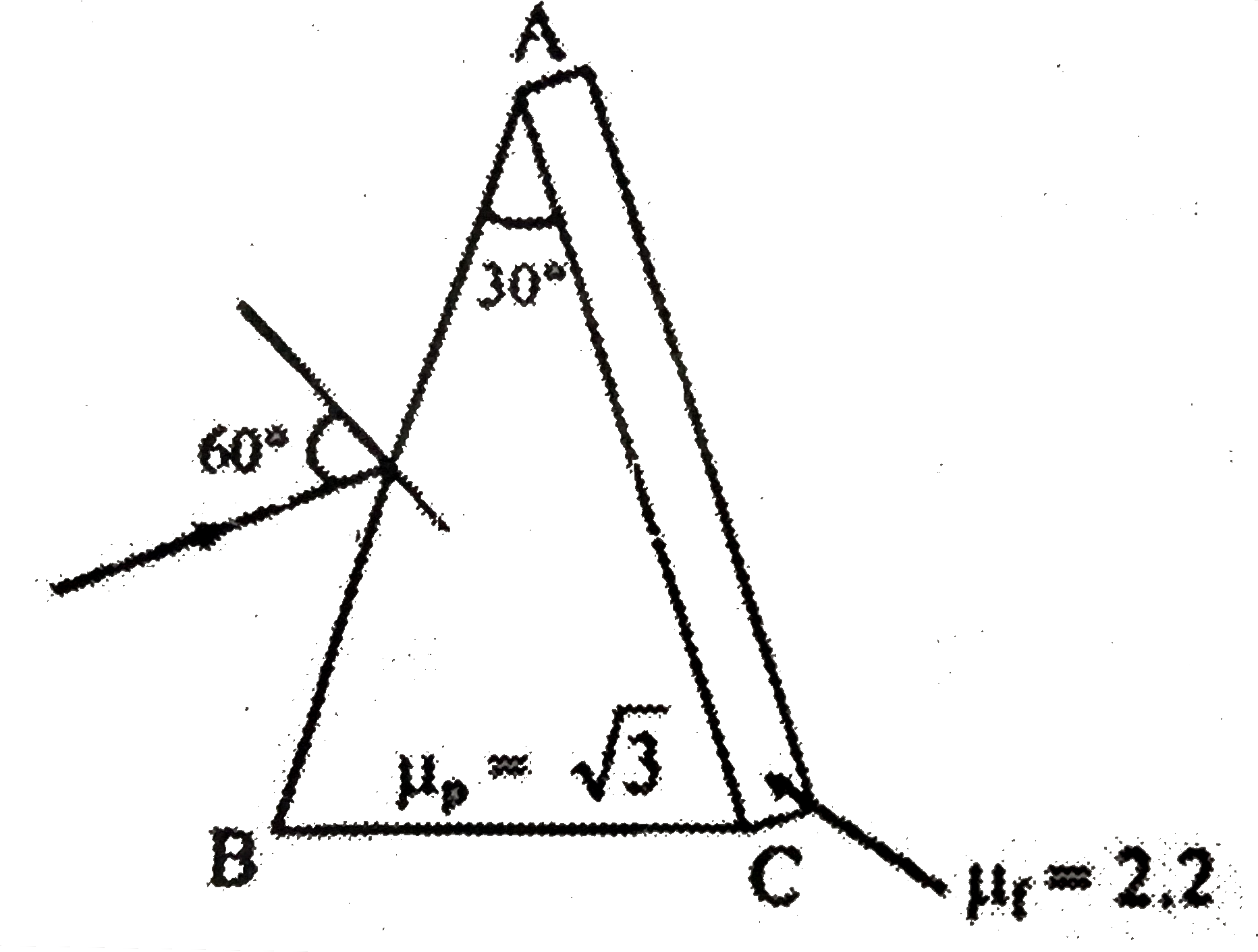Using the tables of the Appendix, calculate the difference of refractive indices of quartz for light wavelength λ=589.5nm with right-hand and left-hand circular polarizations.
Light polarized along the x-direction (i.e. one whose electric vector has only an x component) and propagting along the z−direction can be decomposed into left and right circualry polarized light in accordance with the formula
Ex=12(Ex−iEy)+12(Ex−iEy)
On passing through a distance l of an active medium these acquire the phases δR=2πλnRl and δ1=2πλn1l so we get for the complex amplitude
E'=12(Ex+iEy)eiδR+12(Ex+iEy)eiδL
=elδR+δl2[12(Ex+iEy)eiδ/2+12(Ex−iEy)e−iδ/2]
=elδR+δl2[Excos(δ2)−Eysin(δ2)],δ=δR−δL.
Apart from an over all phase (δR+δ1)/2)(which is irrelevent) this represents a wave whose plane of polarization has rotated by
δ2=πλ(Δn)l,Δn=|nR−n1|
By definition this equals αl so
Δn=αλπ
=589.5×10−6mm×21.72deg/mmπ×π180(rad)
=5895×21.72180×10−3
=0.71×10−4
Topper's Solved these Questions
- BOOK - IE IRODOV, LA SENA & SS KROTOVCHAPTER - OPTICSEXERCISE - Dispersion And Absorption Of Light24videos
OPTICS
- BOOK - IE IRODOV, LA SENA & SS KROTOVCHAPTER - OPTICSEXERCISE - Optics Of Moving Sources22videos
OPTICS
- BOOK - IE IRODOV, LA SENA & SS KROTOVCHAPTER - OPTICSEXERCISE - Diffraction Of Light60videos
OPTICS
- BOOK - IE IRODOV, LA SENA & SS KROTOVCHAPTER - MECHANICSEXERCISE - Mechanics Problems92videos
MECHANICS
- BOOK - IE IRODOV, LA SENA & SS KROTOVCHAPTER - OSCILLATIONS AND WAVESEXERCISE - Electromagnetic Waves, Radiation36videos
OSCILLATIONS AND WAVES
Similar Questions
Monochromatic plane-polarized light with angular frequency ω through a certain substance along a unifrom magnetic field h. Find the difference of refractive indices for right-hand and left-hand components of light beam with circular polarization if the verdet consatnt is equal to V.
View SolutionOne has to manufacture a quartz plate cur parallel to its optical axis and not exceeding 0.50mm is thickness. Find the maximum thickness of the plate allowing plane-polarized light with wavelength λ=589nm
(a) to experience only rotation of polarization plane,
(b) to acquire circular polarization after passing through that plane.View Solution
Knowledge Check
- Question 1 - Select One
Shown in the figure is a prism of angle 30∘ and refractive index μp=√3. Face AC of the prism is covered with a thin film of refractive index μf=2.2 A monochromatic light of wavelength λ =550 nm fall on the face AB at an angle of incidence of 60∘ Calculate angle of emergence
 A0∘B30∘C45∘DNot emerge
A0∘B30∘C45∘DNot emerge - Question 2 - Select One
Preferential filtering of light consisting of different wavelengths can be done using total internal reflection. The concept of filtering lies in the fact that different wavelengths have different refractive indices in a medium The beam of light with different wavelengths are made incident on an isosceles right angled prism as shown in the figure. The wavelength or wavelengths which satisfy the condition of totai internal reflection, θsin≥(1μ), get reflected
Others get refracted, hence gets separated. G is the angle of incidence and u. is the refractive index .of the particular wavelength in that particular medium. Thus, by changing the medium and by changing the angles of the prism we can satisfy the condition df total internal reflection for a particular wavelength, which gets separated out.
Q An experiment was performed based on the above theory with red, green and blue light. Their refractive indices in the material were 1.39, 1.44 and 1.47, respectively. Which colour would get separated?
 AredBgreenCblueDno colour would be separated.
AredBgreenCblueDno colour would be separated. - Question 3 - Select One
Preferential filtering of light consisting of different wavelengths can be done using total internal reflection. The concept of filtering lies in the fact that different wavelengths have different refractive indices in a medium The beam of light with different wavelengths are made incident on an isosceles right angled prism as shown in the figure. The wavelength or wavelengths which satisfy the condition of totai internal reflection, θsin≥(1μ), get reflected
Others get refracted, hence gets separated. G is the angle of incidence and u. is the refractive index .of the particular wavelength in that particular medium. Thus, by changing the medium and by changing the angles of the prism we can satisfy the condition df total internal reflection for a particular wavelength, which gets separated out.
Q If hypothetically the density of the material is increased gradually, then which of the colour gets separated next?
 AredBgreenCblueDnone
AredBgreenCblueDnone
Light with wavelength λ falls on a system of crossed polarizer P and analyzer A between which a Babinet compesator C is inserted (Fig.). The compensator consists of two q2uartz wedges with the optical axis of one of them being parallel to the edge, and of the other, perpendicular to it. The principal directions of the polarizer and the analyser from an angle of 45∘ with the optical axes of the compensator. The refracting angle of the wedges is equal to Θ(Θ<<1) qand the difference of refractive indices of quartz is ne−n0. The insertion of investigated birefringent sample S, with the optical axis oriented as shown in the figure, results in displacement of the fringe upward by δxmm. Find:
the width of the fringe Δx,
(b) the magnitude and the sign of the optical path difference of ordinary and extraordianry rays, which appears due to the sample S.
 View Solution
View SolutionA beam of linearly polarised is change into circularly palarised light by passing it through a slice of cryslal 0.003 cm thick. Calculate the difference n the refractive index of the two rays in the crystal assuming this to be minimum thickness that wil produce the effect and that the wavelength is 6×10−5 cm.
View SolutionA quartz wedge with refracting angle Θ=3.5 is inserted between two crossed Polaroids. The optical axis of the wedge is parallel to its edge and forms an angle of 45∘ with the principal directions of the Polaroids. On transmittion of light with wavelength λ=550nm through this system, an interference fringe pattern is formed. The width of each fringe is Δx=1.0mm. Find teh difference of refractive indices of quartz for ordinary and extraodianry rays at the wavelength indicated above.
View SolutionA quartz plate cut parallel to its optical axis is placed between two corssed Nicol prisms so that principle directions form an angle of 45∘ with the optical axis of the plate. What is the minimum thickness of that plate transmitting light of wavelength λ=643nm with maximum intensity while greatly reducing the intensity of transmitting light of wavelength λ2=564nm? The difference of refractive indieces indices for extroardianry and ordinary rays is assumed to be equal to ne−n0=0.0090 for both wavelengths.
View SolutionPreferential filtering of light consisting of different wavelengths can be done using total internal reflection. The concept of filtering lies in the fact that different wavelengths have different refractive indices in a medium The beam of light with different wavelengths are made incident on an isosceles right angled prism as shown in the figure. The wavelength or wavelengths which satisfy the condition of totai internal reflection, θsin≥(1μ), get reflected
Others get refracted, hence gets separated. G is the angle of incidence and u. is the refractive index .of the particular wavelength in that particular medium. Thus, by changing the medium and by changing the angles of the prism we can satisfy the condition df total internal reflection for a particular wavelength, which gets separated out.
Q Now instead of changing the material of prism, we change one of the angle of prism to 300 Then, which of the colour gets separated?

 View Solution
View Solution

